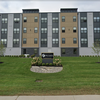Guilderland Planning Board approves 42-lot subdivision
— Lansing Engineering rendering from Barth Meadows submittal to the town of Guilderland
The Guilderland Planning Board on Aug. 27 approved a 42-lot subdivision near Tawasentha Park, which includes six homes on a cul-de-sac accessed through Posson Road with the other 36 homes on the to-be-built Azalea Drive accessed from Route 146.
GUILDERLAND — A developer recently received preliminary approval from the Guilderland Planning Board to build a 42-lot subdivision near Tawasentha Park.
The conditional OK was given to Barth Meadows on Aug. 27, and “constitute[s] approval of the proposed subdivision as to the general character and intensity of development,” according to Town Planner Kenneth Kovalchik’s board memo.
But, as he explained on Aug. 27, work can’t start on the site until after final plat approval, which requires an additional sign-off for water-quality certification from the state’s Department of Environmental Conservation.
Barth has 180 days to submit a final plat or have its project approval revoked.
History
In the spring of 2022, Ken Barth was granted an easement by the town board, providing him access from Route 146 to the proposed development site by way of an existing asphalt driveway that runs through property currently housing Guilderland’s Parks and Recreation Department.
Prior to receiving the easement, Barth had no legal access to Route 146.
The planning board had approved a minor subdivision for Barth in April 2022, allowing Barth to divide his 37-acre property into two parcels: one of 33 acres and the other, which contained his home, of four acres.
In exchange for the easement, the town got one of its own: a 20-foot-wide trail right-of-way that runs for about 1,900 feet along Barth’s eastern and southern property lines.
The easement and subdivision allowed the project to move forward.
Initially presented to Guilderland’s Development Planning Committee during an early-morning meeting in September 2022, Barth’s proposal at the time was for a 70-lot cluster subdivision, with which the committee had a number of issues.
A formal submission request was made to the town in November 2022 for a 66-lot single-family residential cluster subdivision, with 62 of the homes accessible from either Route 146 or Concord Hill Drive and four located in a cul-de-sac at the end of Posson Road.
To determine the number of lots allowed in a conservation or cluster development, Guilderland’s code says a developer has to submit a conventional subdivision plan to show the number of buildable lots that are allowed by an area’s particular zoning.
The Barth development is located in the Residential Overlay (RO40) District, where the minimum conventional lot size is 40,000 square feet. For a cluster development in an R40 District, the minimum lot size is 15,000 square feet.
A developer receives a density bonus, that is, additional buildable lots, for providing “certain amenities,” like putting in sidewalks, protecting historically-significant resources, or allowing public access to conservation areas “in their cluster/conservation subdivision,” according to the town’s zoning code.
Using a conventional subdivision plan, Barth showed 35 single-family homes spread across 87 acres. The housing number doubles when a cluster plan is employed.
By February 2023, the project was back before the planning board.
But before project representatives could start their presentation, Chairman Stephen Feeney sought to make it clear that their 66-lot subdivision would not be accepted as proposed, something the representatives had been aware of for months.
“I thought we were pretty clear in our initial conversation that the bonus RO-40 was not going to apply in this instance,” Feeney said at the time, referring to a Residential Overlay District, whose purpose in town code is to “encourage new development to gain ingress and egress directly with connector streets [routes 20 and 146], thereby reducing traffic within subdivisions.”
Feeney said it was “pretty clear” at the Development Planning Committee meeting that the town code “doesn’t apply in this instance. You’re certainly willing to submit a [66-lot] subdivision but I don’t see where that bonus is going to be supported by the board.”
The RO-40 provision has never been applied by the planning board, Feeney said, “because most properties, quite frankly, can’t really meet the standard in the code.”
Feeney said he didn’t see how this proposal would reduce traffic in the neighboring subdivision.
Feeney added that he thought both Kovalchik and the rest of the planning board agreed with him.
It wasn’t until December 2024 that the project reappeared on the planning board’s agenda, at which time proposal was for a 42-lot subdivision with 36 lots connecting to Route 146 via Concord Hill Drive and the remaining six accessible off of Posson Road.
Kovalchik on Aug. 27 attributed Barth’s latest long-term absence from any board agenda to its focus “on a lot of technical engineering related to the subdivision.”
Phases of construction
After brief discussion on Aug. 27, the planning board moved to approve the project with a number of paperwork-related conditional approvals, but two main conditions identified for the preliminary sign-off were water-quality certification from the DEC and compliance with a construction-phasing letter submitted to the town.
The letter to the town laid out timing for the project:
— Phase 1 focuses on establishing initial site access. Due to limitations with Route 146 and Posson Road, access will temporarily begin at Concord Hill Drive for tree-clearing and road-grading. The main construction entrance will be permanently moved to Route 146 once a stream-crossing box culvert is installed, closing the Concord Hill Drive entrance for the remainder of the project.
Phase 1 is expected to take two to three months;
—Phases 2 and 3 involve installing utilities along the new Azalea Drive as well as constructing two stormwater management basins.
Phases 2 and 3 will take approximately three to six months;
— Phases 4 through 7 focus on developing the 36 residential lots along the new Azalea Drive.
Each of these four phases is expected to take one to two months; and
— Phase 8 extends the project to Posson Road’s six homes. Site access for the final phase will be through a new internal road network.
Phase 8 is estimated to take three to six months.


